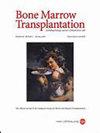Outcomes of human leukocyte antigen matched sibling transplant from consanguineous versus non-consanguineous parents, a single center experience.
IF 4.5
2区 医学
Q1 HEMATOLOGY
Riad El Fakih, Mohamed I Sharif, Shaykhah Alotaibi, Abdulrahman Almujalli, Sara Samarkandi, Salman Almhareb, Yasamiyan Saud Alsgaih, Feras Alfraih, Saud Alhayli, Syed Osman Ahmed, Marwan Shaheen, Naeem Chaudhri, Fahad Alsharif, Amr Hanbali, Ayman Saad, Abdullah Alamer, Alfadel Alshaibani, Mansour Alfayez, Abdulwahab A Albabtain, Hanan Alkhaldi, Ahmad S Alotaibi, Tusneem Elhassan, Fahad Almohareb, Ali Alahmari, Ghulam Mufti, Walid Rasheed, Hazzaa Alzahrani, Mahmoud Aljurf
求助PDF
{"title":"Outcomes of human leukocyte antigen matched sibling transplant from consanguineous versus non-consanguineous parents, a single center experience.","authors":"Riad El Fakih, Mohamed I Sharif, Shaykhah Alotaibi, Abdulrahman Almujalli, Sara Samarkandi, Salman Almhareb, Yasamiyan Saud Alsgaih, Feras Alfraih, Saud Alhayli, Syed Osman Ahmed, Marwan Shaheen, Naeem Chaudhri, Fahad Alsharif, Amr Hanbali, Ayman Saad, Abdullah Alamer, Alfadel Alshaibani, Mansour Alfayez, Abdulwahab A Albabtain, Hanan Alkhaldi, Ahmad S Alotaibi, Tusneem Elhassan, Fahad Almohareb, Ali Alahmari, Ghulam Mufti, Walid Rasheed, Hazzaa Alzahrani, Mahmoud Aljurf","doi":"10.1038/s41409-025-02609-y","DOIUrl":null,"url":null,"abstract":"<p><p>Matching HLA between donor and recipient pairs significantly improves engraftment and decreases GvHD. However, even in HLA matched siblings, the risk of graft failure and GvHD still exist and is partially attributed to the bidirectional alloreactivity generated from minor histocompatibility antigens (miHA) mismatching between donors and recipients. Consanguineous marriage increases the chance of miHA matching. This fact may be an advantage or disadvantage in consanguineous MSD transplants. We retrospectively reviewed our institutional transplant registry and selected AML and ALL patients who received a MSD allo-HCT between January 2006 and December 2020. The objective was to compare the outcomes of transplant among consanguineous vs non-consanguineous pairs. Analysis was conducted using RStudio. Version 1.4.1106 © 2009-2021 RStudio, PBC. 271 patients met the eligibility criteria were included in this study. Sixty-three were consanguineous and 208 were not. The median follow-up time was 72.6 months. The five years OS and DFS were not statistically different between consanguineous and non-consanguineous group. A trend toward a higher relapse rate in the consanguineous group was observed. The five years NRM for the whole group was 10.5% with no statistically significant difference between groups. The grade II-IV aGvHD incidence was 25.8% for the whole group with no statistically significant difference between groups. The all grade cGvHD incidence was 52.8% with no statistically significant difference between groups. Populations with high levels of consanguinity, complex consanguinity loops often arise from cousin marriages across multiple generations. This means that even individuals who consider themselves non-consanguineous may still share genetic traits associated with consanguinity. Therefore, high level of homozygosity probably exist in the non-consanguineous cohort and explain these results.</p>","PeriodicalId":9126,"journal":{"name":"Bone Marrow Transplantation","volume":" ","pages":""},"PeriodicalIF":4.5000,"publicationDate":"2025-04-29","publicationTypes":"Journal Article","fieldsOfStudy":null,"isOpenAccess":false,"openAccessPdf":"","citationCount":"0","resultStr":null,"platform":"Semanticscholar","paperid":null,"PeriodicalName":"Bone Marrow Transplantation","FirstCategoryId":"3","ListUrlMain":"https://doi.org/10.1038/s41409-025-02609-y","RegionNum":2,"RegionCategory":"医学","ArticlePicture":[],"TitleCN":null,"AbstractTextCN":null,"PMCID":null,"EPubDate":"","PubModel":"","JCR":"Q1","JCRName":"HEMATOLOGY","Score":null,"Total":0}
引用次数: 0
引用
批量引用
Abstract
Matching HLA between donor and recipient pairs significantly improves engraftment and decreases GvHD. However, even in HLA matched siblings, the risk of graft failure and GvHD still exist and is partially attributed to the bidirectional alloreactivity generated from minor histocompatibility antigens (miHA) mismatching between donors and recipients. Consanguineous marriage increases the chance of miHA matching. This fact may be an advantage or disadvantage in consanguineous MSD transplants. We retrospectively reviewed our institutional transplant registry and selected AML and ALL patients who received a MSD allo-HCT between January 2006 and December 2020. The objective was to compare the outcomes of transplant among consanguineous vs non-consanguineous pairs. Analysis was conducted using RStudio. Version 1.4.1106 © 2009-2021 RStudio, PBC. 271 patients met the eligibility criteria were included in this study. Sixty-three were consanguineous and 208 were not. The median follow-up time was 72.6 months. The five years OS and DFS were not statistically different between consanguineous and non-consanguineous group. A trend toward a higher relapse rate in the consanguineous group was observed. The five years NRM for the whole group was 10.5% with no statistically significant difference between groups. The grade II-IV aGvHD incidence was 25.8% for the whole group with no statistically significant difference between groups. The all grade cGvHD incidence was 52.8% with no statistically significant difference between groups. Populations with high levels of consanguinity, complex consanguinity loops often arise from cousin marriages across multiple generations. This means that even individuals who consider themselves non-consanguineous may still share genetic traits associated with consanguinity. Therefore, high level of homozygosity probably exist in the non-consanguineous cohort and explain these results.
人类白细胞抗原匹配的近亲与非近亲兄弟姐妹移植的结果,单中心经验。
供体和受体之间的HLA匹配可显著改善移植,降低GvHD。然而,即使在HLA匹配的兄弟姐妹中,移植物失败和GvHD的风险仍然存在,部分归因于供体和受体之间轻微组织相容性抗原(miHA)不匹配产生的双向同种异体反应。近亲婚姻增加了miHA配对的机会。这一事实可能是近亲MSD移植的优势,也可能是劣势。我们回顾性地回顾了我们的机构移植登记,并选择了2006年1月至2020年12月期间接受MSD allo-HCT的AML和ALL患者。目的是比较近亲与非近亲移植的结果。使用RStudio进行分析。Version 1.4.1106©2009-2021 RStudio, PBC。271例符合入选标准的患者纳入本研究。63例是近亲,208例不是。中位随访时间为72.6个月。近亲属组与非近亲属组的5年OS和DFS无统计学差异。观察到近亲组有较高复发率的趋势。全组5年NRM为10.5%,组间差异无统计学意义。全组II-IV级aGvHD发生率为25.8%,组间差异无统计学意义。cGvHD全级别发生率为52.8%,组间差异无统计学意义。高亲缘关系的人群,复杂的亲缘关系通常来自于几代人的表亲婚姻。这意味着,即使是那些认为自己不是近亲的人,也可能拥有与近亲相关的遗传特征。因此,在非近亲队列中可能存在高水平的纯合性,并解释了这些结果。
本文章由计算机程序翻译,如有差异,请以英文原文为准。

 求助内容:
求助内容: 应助结果提醒方式:
应助结果提醒方式:


